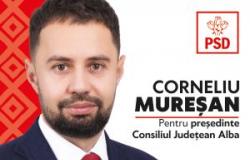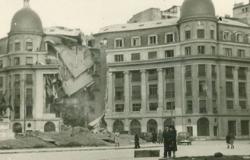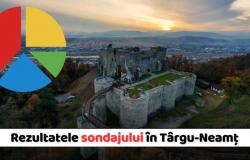Have you ever wondered what happens to satellites that, after orbiting the Earth for a few years, end their mission? Well, most of them are attracted by the gravitational force into the atmosphere, where they burn, being seen with the naked eye as shooting stars.
In some cases, pieces or even whole satellites still resist friction with the air at incandescent temperatures and fall to Earth. Andreea Burlou is also in the team of those who ensure that they do not cause damage, a young woman from Bihor attracted by the mysteries of the high…
A teenage dream
As a child, he never dreamed that he would get this far, but he wanted a job that was out of the ordinary. Raised in Popeşti, Andreea Burlou, now 26 years old, completed her first two years of high school in her hometown, where her father is still a mathematics and physics teacher, then continued at the Aurel Lazăr High School in Oradea, specializing Mathematical Informatics.
That’s when he first thought about a career in aviation. “Knowing that the Faculty of Aerospace Engineering in Bucharest is the only one in the country where a branch of aeronautics is studied, I decided to enroll, because I had nothing to lose. My parents supported me, even if, being their only child, they were skeptical to leave me alone in the Capital”, the young woman remembers.
On the course
It was not easy for him in the beginning, especially since the conditions in the student dormitory were deplorable. “I used to come to visit my friends who were staying in the dormitory, but in Oradea, and I said that here is a different life. In Bucharest, the accommodation spaces are about 30 years ago”, says Andreea.
However, during the student period in the Capital, he would gather a lot of good memories. At the end of the second year, he flew for the first time with small aircraft, at the Clinceni Airport, where he piloted such an aircraft.
A year later, in the third year, he got a job at Fokker, where he did his internship, the company being specialized in the design and production of components for airplanes, including military ones. There he was an aerospace engineer, one of his roles being the design of components strong enough to be used in aircraft construction.
From airplanes to satellites
In 2021, when he also started a master’s degree, he changed his job. She submitted her CV to the company HPS (High Performance Structures) and was hired in a short time.
“There I learned how satellites work and what they are made of. It was fascinating. I did the first thermal analyzes and a bunch of tests to see if a satellite can withstand the temperatures it will be exposed to after launch into orbit, going through all the layers the atmosphere until it reaches space”, the young woman says.
Once in the stratosphere, a satellite is programmed to position itself only in a certain place and at a certain distance from the planet. For example, those on the average orbit gravitate above the Earth at altitudes varying between 10,000 and 20,000 kilometers, being used for GPS signals and in telecommunications, and those on the polar orbit are positioned at angles of 90 degrees to the two poles and Ecuador, providing weather information, about the state of the weather, the ozone layer or deforestation.
On the wings of science
Discovering her passion for studying satellites, after a few months Andreea dared more, applying for a job at Deimos Space Romania, a Spanish company with a branch in Bucharest, which works for the European Space Agency (ESA) producing state-of-the-art satellites . After several difficult interviews, she was accepted into the team and, for almost two years, she was the only engineer in the atmospheric flight department of the branch in the country, being among the few girls in the company, most of the others being Spanish.
“Usually satellites end their mission after 5-10 years. Then it takes an average of 25 years to come down from orbit, because in the past they were not designed with engines, so they are pulled very slowly by the gravitational force of the Earth. Most of them they break up into small pieces, which then burn up during re-entry into the atmosphere due to intense heat and aerodynamic forces. Seen with the naked eye, they look like shooting stars (photo). Their remains are not, however, a threat, even if there were exceptions, which ESA wants to avoid in the future through the new generation of satellites”, explains Andreea.
Recycling in space
His role is a crucial one in the company, because he programs the satellite so that when it descends to Earth it will provide location data, to be directed to a so-called Point Nemo, a dry area in the South Pacific Ocean, considered the most isolated area on the planet, where all satellites that survive after entering the atmosphere are finally sent to be recovered. “The ones that resist are usually the bigger metal assemblies that have titanium in their composition,” says the engineer.
In the future, her work will be even more important, because ESA is preparing new strict rules for launching satellites, to avoid the creation of space debris, that is, the remains of satellites that remain orbiting around the Earth, already in the order of tens of thousands. “The project we are working on now is a so-called space rider (in Romanian – space rider), the first robotic laboratory that will be launched into space and will stay there for several months, also doing research. It is designed so that when it lands, a paraglider will open to allow it to land on a runway, so it can then be reused in new missions. Practically, the first reusable space vehicle”, says Andreea.
Because order and sustainability are, she says, just as important beyond the clouds as on Earth…
NOMAD ENGINEER
Discover the beauties of the earth
Free spirit and adventurer, Andreea Burlou travels every time she has the opportunity, especially since she works from home for Deimos Space Romania. In fact, this allowed him to move to Oradea, where his lover lives, whom he will marry this year. Along with him, every few months he discovers another corner of the world, such as Estonia, Latvia, Georgia, Portugal, Colombia, South Korea, Mexico, Turkey and Argentina.
Often, however, he also works when he takes a vacation. “I like what I do, that’s why I don’t even feel strange if I turn on my laptop on a day when I’m free, even if I’m in a place that I can’t wait to discover,” says the young woman.









